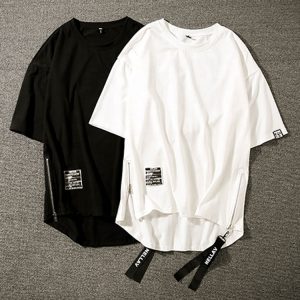T-shirts are one of people’s favorite clothing. T-shirts have gradually replaced the old pattern of men wearing a vest or undershirt plus a short-sleeved shirt or Hong Kong shirt with their natural, comfortable, chic and solemn advantages. Appearing in social occasions, it becomes the seasonal clothing that people are willing to wear. It has become a fashionable dress that men, women and children all over the world love to wear. It is said that the annual sales volume in the world has reached billions, constituting the most popular and most worn clothing in the world.
1. What is grammage?
Gram weight is generally used to indicate the thickness of the fabric, the greater the weight, the thicker the clothes. The weight of a T-shirt is generally between 160 grams and 220 grams, too thin will be very transparent, too thick will be stuffy, generally choose between 180-260 grams. (Short-sleeved T-shirts are generally based on 180-220 grams. This thickness is just right to wear. Long-sleeved T-shirts generally choose 260 grams of fabric, which is thicker)
2. What is the count?
Definition: The number of length yards of cotton yarn with a nominal weight of one pound.
Coarse count yarn: pure cotton yarn with 18 counts or less, mainly used for weaving thick fabrics or piled looped cotton fabrics.
Middle count yarn: 19-29 count pure cotton yarn. Mainly used for knitted garments with general requirements.
Fine yarn: pure cotton yarn with 30-60 counts. Mainly used for high-grade knitted cotton fabrics. The higher the count, the softer the T-shirts are generally 21 and 32.
3. What is combing?
T-shirt cotton yarn can be divided into carded and combed yarn.
Carded yarn: refers to the yarn spun by the carded spinning process, also called uncombed yarn.
Combed yarn: refers to the yarn produced by using high-quality cotton fiber as the raw material and adding a combing process to that of carded yarn during spinning. The surface of the fabric is relatively neat, and the hand feels very soft.
4. What are the processes for T-shirt printing?
T-shirt printing is basically divided into screen printing and transfer printing.
Screen printing: The technology is relatively complex, mainly including design, film production, printing, printing, and drying steps. The advantages of screen printing are high color fastness, durability and washability. The screen printing plate-making cost is relatively high, so mass production is required to reduce the cost, and it cannot meet the printing of single or very small batches. Transfer printing: also known as heat transfer. The advantages are bright color and simple technology. The disadvantage is that the pattern is not durable, not resistant to abrasion, and not resistant to washing.
5. How to singe T-shirts?
The characteristic of singeing treatment is to remove the fluff formed on the surface of the yarn due to unwound fibers and protruding fibers, so that the fabric is smoother and more beautiful, and the color of the fabric is uniform, and it can print clear and fine patterns.
6. What are the advantages of T-shirt pure cotton fabric? Why add spandex?
The characteristic of pure cotton fabric is that it feels good in the hand, comfortable to wear and environmentally friendly, but it is easy to wrinkle. Adding a small amount of spandex yarn can significantly change the physical properties of the fabric, greatly increase the elasticity of the fabric, while maintaining the texture and comfort of pure cotton. In addition, adding spandex to the neckline can prevent the neckline from becoming loose and deformed and maintain the lasting elasticity of the neckline.
























